Abstract
We present a client–server framework for the development of mobile applications that use augmented reality to visualize geo-located data. We provide a scalable and flexible architecture for development and management of the client, server, and data that are used by the applications. The idea is based on the concept of a layer that contains information related to the real environment that is displayed by the device. Information that enhances reality is identified as points of interest by their geographic coordinates. Layers can also be organized in a hierarchical model as a tree-like structure. We present four case studies that demonstrate the flexibility and generalizability of our framework: management of electrical power line failures, support for hydrogeological monitoring, management of sensor networks, and geo-localization of tourist attractions.








Similar content being viewed by others
References
Azuma RT (1997) A survey of augmented reality. Presence Teleoper Virtual Environ 6(4):355–385
Bane R, Hollerer T (2004) Interactive tools for virtual X-ray vision in mobile augmented reality. In: Proceedings of the 3rd IEEE/ACM international symposium on mixed and augmented reality. Washington, DC, USA: IEEE Computer Society, pp 231–239
Capece N, Agatiello R, Erra U (2016) A client–server framework for the design of geo-location based augmented reality applications. In: 2016 20th international conference information visualisation (IV), pp 130–135
Carotenuto F, Erra U, Scarano V (2014) Slam map application for tracking lights on car dashboards. In: De Paolis LT, Mongelli A (eds) Augmented and virtual reality: first international conference, AVR 2014, Lecce, Italy, September 17–20, 2014, revised selected papers. Springer, Cham, pp 413–420
Choi J, Jang B, Kim GJ (2010) Organizing and presenting geospatial tags in location-based augmented reality. Pers Ubiquit Comput 15(6):641–647
Das P, Zhu M, McLaughlin L, Bilgrami Z, Milanaik RL (2017) Augmented reality video games: new possibilities and implications for children and adolescents. Multimodal Technologies and Interaction 1.2. http://creativecommons.org/licenses/by/4.0/
Delić A, Domančić M, Vujević P, Drljević N, Botički I (2014, Sept) Augeo: a geolocation-based augmented reality application for vocational geodesy education. In: Elmar (elmar), 2014 56th international symposium, pp 1–4
Delisle M (2009) Mastering phpMyAdmin 3.1 for effective MySQL Management. Packt Publishing, Birmingham
Erra U, Colonnese V (2015) Experiences in the development of an augmented reality dressing room. In: De Paolis LT, Mongelli A (eds) Augmented and virtual reality: second international conference, AVR 2015, Lecce, Italy, August 31–September 3, 2015, proceedings. Springer, Cham, pp 467–474
Fielding RT, Taylor RN (2002) Principled design of the modern web architecture. ACM Trans Internet Technol 2(2):115–150
Furht B (2011) Handbook of augmented reality. Springer, Berlin
Geiger P, Schickler M, Pryss R, Schobel J, Reichert M (2014) Location-based mobile augmented reality applications: challenges, examples, lessons learned. In: 10th int’l conference on web information systems and technologies (Webist 2014), special session on business apps, pp 383–394
Geroimenko V (2012) Augmented reality technology and art: the analysis and visualization of evolving conceptual models. In: 16th international conference on information visualisation, IV 2012, Montpellier, France, July 11–13, 2012. IEEE Computer Society, pp 445–453
Global Industry Analysts (2015) Mobile augmented reality (MAR) market trends. Global Industry Analysts. http://www.strategyr.com/MarketResearch/Mobile_Augmented_Reality_MAR_Market_Trends.asp
Hincapie M, Caponio A, Rios H, Mendivil E (2011) An introduction to augmented reality with applications in aeronautical maintenance. In: Transparent optical networks (ICTON), 2011 13th international conference on, pp 1–4
Li H (2011, Sept) Restful web service frameworks in Java. In: Signal processing, communications and computing (ICSPCC), 2011 IEEE international conference on, p 1–4
Louvel J, Templier T, Boileau T (2012) Restlet in action: developing restful web apis in Java. Manning Publications Co, Greenwich
Lupp M (2011) Open geospatial consortium. In: Shekhar S, Xiong H (eds) Encyclopedia of GIS. Springer, Berlin, p 815
Lützenberger M, Masuch N, Küster T, Freund D, Voß M, Hrabia CE, Albayrak S (2015) A common approach to intelligent energy and mobility services in a smart city environment. J Ambient Intell Hum Comput 6(3):337–350
Madden L (2011) Professional augmented reality browsers for smartphones: programming for junaio, layar and wikitude, 1st edn. Wiley, Oxford
Metaio DOC doc description [Computer software manual] (2015). http://dev.metaio.com/sdk/documentation/. Accessed 2 Feb 2015
Schall G, Mendez E, Kruijff E, Veas E, Junghanns S, Reitinger B, Schmalstieg D (2009) Handheld augmented reality for underground infrastructure visualization. Pers Ubiquit Comput 13(4):281–291
Schall G, Schmalstieg D, Junghanns S (2002) The use of augmented reality, GPS and INS for subsurface data visualization. In: XXII international congress of the FIT. Washington, DC, USA, pp 1–12
Shreiner D, Group TKOAW (2009) OpenGL programming guide: the official guide to learning OpenGL, versions 3.0 and 3.1, 7th ed. Addison-Wesley Professional
Sinnott RW (1984) Virtues of the haversine. Sky Telesc 68(2):158
Wang M, Callaghan V, Bernhardt J, White K, Peña-Rios A (2017) Augmented reality in education and training: pedagogical approaches and illustrative case studies. J Ambient Intell Hum Comput pp 1–12
Widenius M, Axmark D (2002) Mysql reference manual, 1st edn. O’Reilly & Associates Inc., Sebastopol
Wilde E, Pautasso C (2011) Rest: from research to practice, 1st edn. Springer, Berlin
Wingfield N, Isaac M (2016) Pokémon go brings augmented reality to a mass audience. The New York Times. https://www.nytimes.com/2016/07/12/technology/pokemon-go-brings-augmented-reality-to-a-mass-audience.html?_r=0. Accessed 2 Feb 2015
Author information
Authors and Affiliations
Corresponding author
Rights and permissions
About this article
Cite this article
Erra, U., Capece, N. Engineering an advanced geo-location augmented reality framework for smart mobile devices. J Ambient Intell Human Comput 10, 255–265 (2019). https://doi.org/10.1007/s12652-017-0654-6
Received:
Accepted:
Published:
Issue Date:
DOI: https://doi.org/10.1007/s12652-017-0654-6




